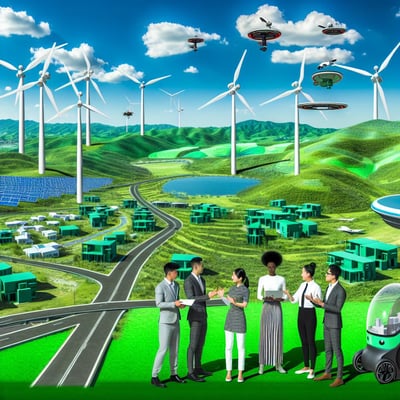With innovations and new technologies prompting significant progress in this field, leaders with engineering, business, finance, and policy backgrounds are playing important roles.

With energy consumption and natural resource use rising steadily, changemakers in energy and clean technology tackle the impact on our natural world by improving efficiency, developing renewable energy sources, and reducing waste and emissions. With innovations and new technologies prompting significant progress in this field, leaders with engineering, business, finance, and policy backgrounds are playing important roles.
-
Electricity generation, transportation, and other human activities increased greenhouse gas emissions in the U.S. by 14% from 1990 to 2008.
-
The U.S. used nearly 14,000 kWh of energy per capita in 2008, compared to 6,000 in the United Kingdom and less than 3,000 worldwide.
-
Americans generated 250 million tons of trash in 2010, but only recycled or composted about a third of it.
-
Wind is the fastest growing energy source in the United States, but currently only accounts for 2.4% of total energy use.
-
Interest in sustainability and energy is growing, with $270 billion invested in renewable energy solutions in 2014 alone.
-
Experts predict that solar power will account for 27% of the world’s energy sources in 2050, making it the largest contributor to energy.
The Lowdown: What can you expect if you decide to go into the energy and cleantech field?
Technology is half of cleantech
The field needs business leaders, funders, and policy wonks to keep things rolling, but don’t expect to get too far without at least a semi-technical understanding of how energy is generated and transmitted, how new technologies work, and the technical barriers and opportunities that exist.
Dedication to change
In this rapidly growing sector, successful professionals respond well to change, are ready to grow, and have their pulse on what’s next so they can innovate effectively. If you like directions laid out for you or want a well-defined professional ladder to climb, this might not be your space.
Space for go-getters
Despite the sector’s growth, demand for jobs in energy and clean technology remains higher than supply. To break into the field, be prepared to network like crazy, build your skills in more traditional roles, or start your own venture. As we go digital for our annual Net Impact conference, be sure to remain updated to connect with students, young professionals, and industry leaders in sustainable energy solutions.
Meet the players: Who's addressing energy and cleantech issues, and how?
Traditional energy
Traditional energy firms include oil and gas producers (like Chevron) and electricity providers (utilities like PG&E). Both sides have their feet in the conventional and renewable energy worlds, with big money and lots of brains thinking about our energy future. Their mixed portfolios include fossil fuels like petroleum and coal, natural gas, nuclear energy, and a plethora of newer technologies like wind and solar.
Cleantech companies
Clean tech companies (like Solar City and Tesla Motors) generally develop products or services for one piece of the cleantech market, such as solar cell manufacturing, lighting or insulation solutions, or biofuel technology.
Traditional companies
-
Industrial conglomerates like Siemens, Johnson Controls and GE, engage in all facets of energy and cleantech, from wind turbine manufacturing to metering controls for energy management.
-
Companies have introduced new products to address market needs related to cleantech (such as the Chevrolet Volt).
Investors and investment banks
With angel and seed funding through institutional investing, investors support all stages of cleantech players. Some investing institutions like RockPort Capital specialize in energy or cleantech, while traditional firms like Goldman Sachs may have teams with industry specialties. Read more in our Finance and Investing overview.
Government
Tax breaks, low-interest loans, subsidies, and research grants support the development of new technologies, while environmental regulations and tax policies pressure companies to reduce emissions and seek alternatives in their manufacturing, energy sources and product development.
Other
-
Consulting and research firms like Clean Edge offer thought leadership and strategic expertise, and frequently engage in new project design and implementation.
-
Nonprofits and social enterprises like Green for All provide education and clean tech job training, lobby for greener policies, and serve as incubators or innovators of cutting-edge technologies.
Options within the field
-
Renewable and alternative energy focuses on driving down the costs and improving the effectiveness of alternative – often cleaner and/or renewable – sources of energy, including solar, wind, biofuels, and geothermal.
-
Utility infrastructure includes building “smart grid” capabilities in energy transmission and distribution; incorporating renewables into utilities’ traditional energy models; and developing efficient means of energy storage.
-
Energy efficiency involves building design and LEED certification; LED lighting and control systems for lighting, heating, AC, and equipment are also important.
-
Transportation includes the development of electric vehicles and changes to infrastructure, including public transit, high-speed rail, and electric vehicle plug-ins.
-
Waste and wastewater: Innovations are generating significant reduction in waste, improving recycling and the usability of recycled materials, and improving water use and wastewater treatment in industrial processes.
-
Policy plays a major role in the sector at the local, state, and federal level.
Getting Started
All of this information might be a little overwhelming. You may be wondering: Where do I begin?
Articles
Hear from Future of Energy Challenge: Mobility Winning Team - Petal Transport
Net Impact Supports the Climate Strike Movement
"I want a career in sustainability" may not be the right approach
Three ways we’re making our food matter
Future Proof for 2020: Do You Have the Top 5 Sustainability Skills to Survive?
Is Business Doing Enough to Affect Climate Change?

